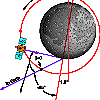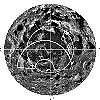  |
Science magazine
published an article where the authors report the possible presence of
water ice in the permanently shadowed region at the south pole of the Moon.
Is only a possibility, already suggested in 1961. Volatiles degassed from the primitive Moon or deposited on the lunar surface by cometary and asteroidal impacts might migrate and collect in permanently shadowed cold traps near the lunar poles, where they could be stable over geologic time. The Mariner 10 spacecraft make a flyby over the Mercury south pole in 1974-1975. Years later, water ice was detected there with the Arecibo radiotelescope. The same technique used with Mercury data at Arecibo (1993) has been used now to estimate the extent of the area of putative south pole ice deposits: 90 to 135 square km. |